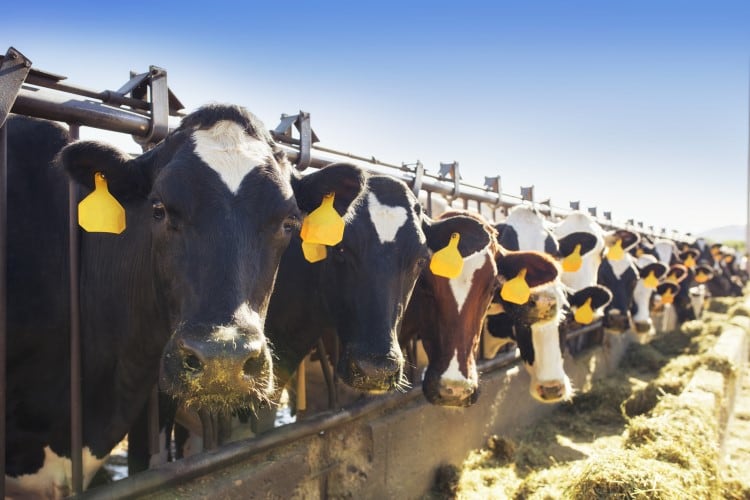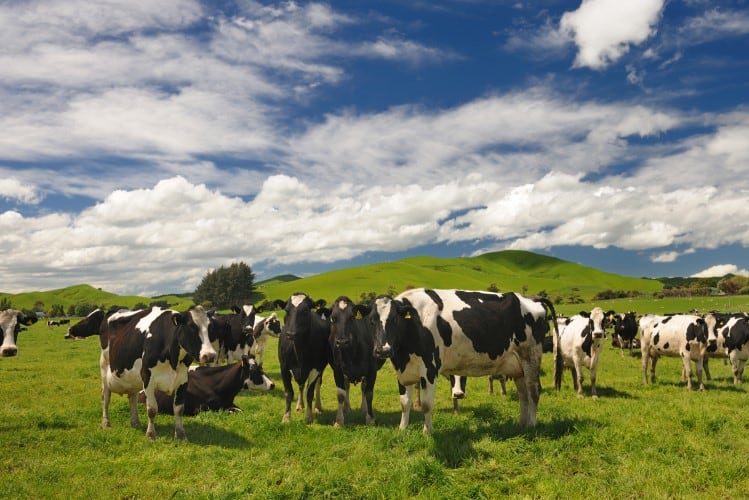Danone, Nestlé, Lactalis USA, General Mills, Kraft Heinz and Bel Group have joined forces in a new industry partnership led by the global nonprofit Environmental Defense Fund (EDF) in a bid to foster transparency and accountability on methane emissions from dairy supply chains.
As part of the Dairy Methane Action Alliance, each company has committed to two key milestones - measure and publicly disclose their methane emissions, and produce a public action plan detailing how these dairy-related methane emissions will be reduced.
Katie Anderson, senior director, EDF+Business, Food & Forests, explained: “The action plan is going to need to be tailored to specific geographies and each company is going to have a different way of doing that based on where it is sourcing from and what the specific opportunities are in that context. So it needs to be very tailored to their specific strategies."
The companies will have until mid-2024 to disclose their methane emissions and the action plans to be finalized by the end of 2024, with EDF providing technical guidance with best-possible emissions factors “to help companies understand how to go from their full scope to the methane components in it,” as Anderson said. The non-profit organization will also offer support with best practices for accounting and disclosure, and access to new research and emerging solutions, while the sustainability nonprofit Ceres will lead the development of a methane action plan template and will assist EDF with reviewing the companies’ progress, which will also be released to the public.
When asked if the six CPG firms would need to align their efforts to meet a common methane reduction target, however, Anderson’s answer was negative. “Methane-specific reduction targets are not required at this time,” she told DairyReporter during an embargoed press briefing. “Companies can be ‘nesting’ them within their broader set of climate actions, so whether that’s a methane target like Danone’s or a science-based target that any of these companies have or any other climate targets that they have. This is really about putting a spotlight and driving action and accountability on methane specifically.”
Pressed on how accountability can be achieved without targets, she added: “When you are reporting on methane and disclosing it separately, creating a methane action plan, those are the tools that we see as really critical to help companies drive down their emissions over time. This does mean that these companies are stepping forth and saying ‘we are going to be accountable on this’.
“As EDF, we are a science-led organization so we want to make sure that these companies’ actions are delivering the big impacts that we know that we need to see by 2030. And reducing methane is one of the most critical factors that the sectors can do.”
Chris Adamo, vice-president public affairs and regenerative agriculture policy at Danone, said there was ‘not one silver bullet’ when it comes to supporting farmers in their transition to less methane-intensive farming practices. “We have to look at this full spectrum of different options,” he told us. “We know that there are three levers for working across dairy – herd management, manure management and solutions and innovations towards enteric fermentation reductions.
“As a buyer, we are partnering directly with these farmers on a number of different investment ideas. We work with farmers to hear what they want to install, what works for them. They all may have different needs so we have to fit the solutions to those types of farms and we’re going to learn from them.
“We have been working already in the US on manure management infrastructure investing heavily with much more to come, we have been working to bring feed additives such as Bovaer into European farms, and working with smallholders across Northern Africa through our business in Morocco to increase efficiency. So, a number of these levers have been pushed.”
On supporting farmers financially, Adamo said: “The financial systems will need to be adapted for what those options are and what the localities require. We’ll have to create different incentive programs and different ways that we can compensate those farms for those investments and look at co-finance them. Also, where policy is an option to be leveraged, that will help us accelerate and scale even farther.”
EDF has encouraged more companies to join the Alliance. Anderson said: “This initiative represents many years of work from EDF and these companies and it’s really just the beginning. We invite companies across the sector to join us in 2024 on this journey.”
An alliance without aligned reduction targets
The International Dairy Federation (IDF) has been among the first trade organizations to welcome the new initiative, with director general Caroline Emond stating that it is ‘a good example of how, with its dynamic nature, forward thinking and collective action, the sector will be able to address the triple challenge of providing food security, livelihoods, and environmental sustainability in a rapidly changing world’.
But whether the initiative’s key milestones – public methane emissions reporting and the creation of a plan of action to reduce these emissions – will be sufficient to elicit change from some of the largest dairy producers remains to be seen. It would be encouraging to see publicly available data on each company’s methane footprint, though it’s no secret that enteric methane forms the largest part of dairy companies’ value chain emissions.
The lack of a methane-specific reduction requirement, however, is more problematic - even if EDF has vowed to ensure that companies will deliver impactful changes by 2030. This makes the partnership an alliance without aligned reduction targets where public scrutiny would be a key factor in forcing big brands to act on their promises.
Among the founding members, Danone is the only firm to have set out methane-specific reduction targets for dairy, and environmental commitments among all six vary significantly.
General Mills has pledged to reduce absolute GHG emissions across its full value chain (scopes 1, 2 and 3) by 30% by 2030 compared to a 2020 baseline; the firm aims to be net-zero by 2050. In its recently-released sustainability report, the company reported that it reduced emissions by 1% across its entire value chain on the 2020 baseline; scope 1 and 2 emissions were 49% down on 2020 but scope 3 emissions ‘remain a challenge to our full value chain progress’, the company stated, adding that it was developing ‘an enhanced climate roadmap’ to help it meets its objectives.
Lactalis Group, parent of Lactalis US, is yet to publish a scope 3 (value chain) emissions baseline, something the firm has pledged to do by 2024. In its 2022 sustainability report, the Group reported that its upstream supply chain accounts for over 80% of its total scope of emissions, and fresh milk is the main source of indirect carbon emissions. The company has pledged to reduce operational GHG emissions (scope 1 &2) by at least 25% by 2025 and by at least 50% by 2033, aiming for ‘net zero carbon’ by 2050.
Kraft Heinz has admitted that the majority of GHG emissions are indirect (scope 3) emissions, with agricultural and ingredient-related emissions being particularly significant. The company has ambitions to achieve net zero carbon emissions by 2050, with measures identified by the company to tackle methane from meat and dairy ingredients include the use of methane inhibitors and anaerobic digesters. According to the firm’s latest ESG report, the majority of Kraft Heinz’s actions have been targeted at achieving operational emissions reductions, such as switching to renewable energy sources or making packaging compostable or recyclable. But while scope 1 and 2 emissions have gone down, scope 3 emissions have increased.
Danone made headlines in January by becoming the first food company to release a methane-specific target. The company said it would aim for a 30% absolute reduction in methane emissions from fresh milk through means such as regenerative dairy practices, and its commitment to this partnership is set to reveal more detail on how the French food group is planning to tackle methane emissions from different farming systems and geographies.
Bel Group is targeting a net reduction of 25% of GHG emissions across its entire value chain by 2035, in part by using methane-suppressing feed additives and by growing its portfolio of dairy alternatives. The company has in the past 14 months partnered with precision fermentation start-up Standing Ovation to develop animal-free casein for cheese, and with artificial intelligence specialist Climax Foods, who will help Bel select the most suitable types of plants to formulate superior non-dairy cheese. Bel, which joined the SBTi in 2017, is also targeting carbon neutrality in its plants by 2025 as ‘a first definite step’ in its action to reduce its environmental impact.
Nestlé’s efforts to tackle methane have been criticized by environmental NGOs over the years. In a 2021 report, the Changing Markets Foundation said the company was ‘completely failing to bring the scale necessary to tackle its methane emissions as part of its net-zero pledge’ and called on the largest global food company to improve its accounting, reporting and transparency overall. In response, Nestlé told DairyReporter's sister publication FeedNavigator: "We stand by our climate roadmap; we are focused on reducing our emissions to meet our net-zero target, which we are on track to do. Peak carbon is behind us, and we have reduced our emissions to a level now below our 2018 baseline. We will continue to invest in R&D, in our sustainability initiatives, and in projects that encourage the adoption of regenerative agriculture practices across our supply chain. We are currently exploring solutions related to feed additives and the diet and digestion of the animal. We are looking at their efficacy and safety, including reduction of methane emissions."
Nestlé is targeting a 20% emissions reduction by 2025, rising to 50% by 2030 and has a net-zero emissions target by 2050 ‘at the latest’.
DairyReporter will bring you more reactions to this story during the day as we get them – please refresh the page to check for updates.
Reaction
Responding to the announcement Nusa Urbancic, CEO of the Changing Markets, said: “The commitment by dairy companies to report on their methane emissions is a step in the right direction. This must be quickly followed with clear targets for methane reductions and a plan to deliver on them if it is to have an impact. Today’s big disappointment is the absence of dairy giants like Arla, Fonterra and Dairy Farmers of America which are opting out of action on their main source of emissions.”
Changing Markets told DairyReporter that Arla, Fonterra and DFA had been specifically approached to join the alliance.


